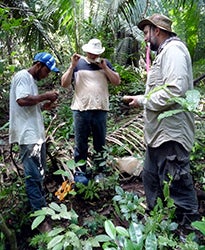The University of Oregon's genetics research capabilities will be at the forefront of a multi-institutional study of how the conversion of Brazil's Amazon rainforests into farmland affects the production and consumption of methane – a greenhouse gas – by microbes in the soil.
Co-leading the new five-year project, which launches in January, is Brendan Bohannan, professor in the Department of Biology and member of the UO Institute of Ecology and Evolution. The UO will provide genome-sequencing tools available in the UO Genomics Core Facility and employ computer-modeling capabilities of the UO's cloud computing center ACISS (Applied Computational Instrument for Scientific Synthesis).
"This project fits into a few ongoing themes at the UO, including the growth of the environmental sciences, the increasing international reach of the university and the current push to harness 'big data' gathering and analyses," Bohannan said. "We will be involved in large-scale sequencing of microbial genomes found in soil, and we will use complex computer modeling to link the genes of soil microbes to environmental processes such as methane release."

The work will be done in two sites in the Amazon basin of Brazil – a western site in the Brazilian state of Rondonia, one of the most deforested regions in the Amazon, and an eastern site in the state of Para, near the city of Santarem. The project, Bohannan noted, is an extension of previous research by UO scientists in the region and related work in Africa.
Researchers hope to identify microorganisms involved in methane production and consumption, understand their genetic makeup and functioning, and learn how changes in the genetics of the microorganisms during deforestation work in an intricate network to move methane from the soil into the atmosphere. Methane is the main component of natural gas, but it also is a greenhouse gas that packs some 20 times more warming power than carbon dioxide.
The UO will receive $609,000 from the National Science Foundation – the largest of three related grants totaling $1.55 million to three institutions for the project from the NSF's Dimensions of Biodiversity Program. Study co-leaders Jorge Rodrigues of the University of California, Davis, and Scott Saleska of the University of Arizona will receive $483,000 and $457,000, respectively. Researchers from the University of Massachusetts, Amherst, and four Brazilian institutions also will participate.
The project also will be supported by a $1.6 million award from Brazil's FAPESP, the leading scientific-funding arm of the Sao Paulo Research Foundation.
The team's approach, Bohannan said, will address two gaps involving biodiversity. First, researchers aim to learn how various aspects of microbial diversity are interrelated, mainly through genetics, and how such diversity responds to environmental change.
"The research will equip scientists in both countries with the skills and knowledge to work on an international scale to ask fundamental questions related to biodiversity and global environmental change," he added.
The NSF grants are DEB-1442109 to Bohannan, DEB-1442214 to Rodrigues and DEB-1442152 to Saleska.
Brendan Bohannan from International Ducks on Vimeo.
—By Jim Barlow, Public Affairs Communications

